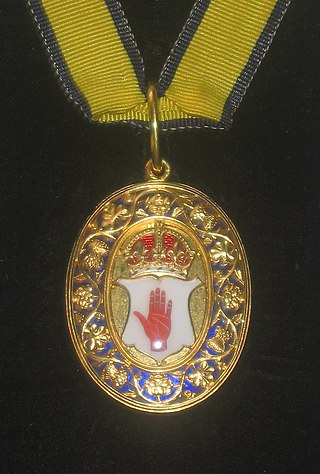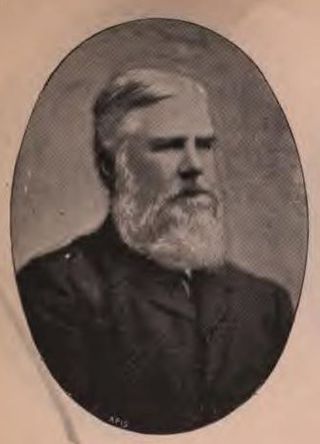Gallery
- Escutcheon of the Hoare baronets of Annabella
- Escutcheon of the Hoare baronets of Barn Elms
- Escutcheon of the Hoare baronets of Sidestrand Hall
There have been four baronetcies created for people with the surname Hoare, one in the Baronetage of Ireland, one in the Baronetage of Great Britain and two in the Baronetage of the United Kingdom. The second holder of the third creation was raised to the peerage as Viscount Templewood in 1944.
The Hoare baronetcy, of Annabella in the County of Cork, was created in the Baronetage of Ireland on 10 December 1784 for Joseph Hoare. He represented Askeaton in the Irish House of Commons for many years and voted against the Act of Union in 1800 at the age of over 90. The second baronet sat as a member of the Irish Parliament for Carlow.
The Hoare baronetcy, of Barn Elms in the County of Surrey, was created in the Baronetage of Great Britain on 27 June 1786 for Richard Hoare. He was the son of Sir Richard Hoare, Lord Mayor of London in 1745, and the great-grandson of Sir Richard Hoare, Lord Mayor of London in 1712 and the founder of the banking firm of C. Hoare & Co. The fifth baronet sat as a Liberal member of parliament for Windsor and Chelsea. The family seat was Stourhead in Wiltshire until 1946, and is now Luscombe Castle, Dawlish, Devon, England.
The Hoare baronetcy, of Sidestrand Hall in the County of Norfolk, was created in the Baronetage of the United Kingdom on 7 August 1899. For more information on this creation, see Viscount Templewood.
The Hoare baronetcy, of Fleet Street in the City of London, was created in the Baronetage of the United Kingdom on 6 December 1962 for Frederick Alfred Hoare. The title became extinct on his death in 1986.
The heir apparent is the present holder's son Simon Merrick Hoare (born 1967).

A baronet or the female equivalent, a baronetess, is the holder of a baronetcy, a hereditary title awarded by the British Crown. The title of baronet is mentioned as early as the 14th century; however, in its current usage it was created by James I of England in 1611 as a means of raising funds for the crown.

Marquess of Headfort is a title in the Peerage of Ireland. It was created in 1800 for Thomas Taylour, 2nd Earl of Bective.

Earl of Kingston is a title in the Peerage of Ireland. It was created in 1768 for Edward King, 1st Viscount Kingston. The Earl holds the subsidiary titles Baron Kingston, of Rockingham in the County of Roscommon, Viscount Kingston, of Kingsborough in the County of Sligo, Baron Erris, of Boyle in the County of Roscommon, and Viscount Lorton, of Boyle in the County of Roscommon, also in the Peerage of Ireland. He is also a baronet in the Baronetage of Ireland. Between 1821 and 1869 the earls also held the title Baron Kingston, of Mitchelstown in the County of Cork, in the Peerage of the United Kingdom.

Earl of Lonsdale is a title that has been created twice in British history, firstly in the Peerage of Great Britain in 1784, and then in the Peerage of the United Kingdom in 1807, both times for members of the Lowther family.

Baron Milford is a title that has been created three times, once in the Peerage of Ireland and twice in the Peerage of the United Kingdom. All three creations have been for members of the same family. The first creation came in the Peerage of Ireland in 1776 when Sir Richard Philipps, 7th Baronet, of Picton Castle was made Baron Milford. However, this title became extinct on his death in 1823, while the baronetcy was passed on to a distant relative. The title was revived in the Peerage of the United Kingdom in 1847 when Sir Richard Philipps, 1st Baronet, of Picton Castle was created Baron Milford, of Picton Castle in the County of Pembroke. Born Richard Bulkeley Philipps Grant, he was the son of John Grant and Mary Philippa Artemisia, daughter of James Child and Mary Philippa Artemisia, daughter of Bulkeley Philipps, uncle of the first Baron of the first creation. He succeeded to the Philipps estates in 1823 and assumed the surname of Philipps the same year. In 1828 he was created a Baronet, of Picton Castle in the County of Pembroke, in the Baronetage of the United Kingdom. However, Lord Milford was childless and the titles became extinct on his death in 1857. He devised his estates to his half-brother Reverend James Henry Alexander Gwyther, who assumed the surname of Philipps. James's daughter Mary Philippa married Charles Edward Gregg Fisher, who assumed the surname of Philipps and was created a Baronet, of Picton, in 1887.

Baron Burnham, of Hall Barn in the Parish of Beaconsfield in the County of Buckingham, is a title in the Peerage of the United Kingdom. It was created on 31 July 1903 for the influential newspaper magnate Sir Edward Levy-Lawson, 1st Baronet, owner of The Daily Telegraph. He had already been created a Baronet, of Hall Barn in The Parish of Beaconsfield in the County of Buckingham and of Peterborough Court in the City of London, in the Baronetage of the United Kingdom on 13 October 1892. Levy-Lawson was the son of Joseph Moses Levy, who acquired The Daily Telegraph only months after its founding.

Viscount Templewood, of Chelsea in the County of Middlesex, was a title in the Peerage of the United Kingdom. It was created on 14 July 1944 for the Conservative politician and former Foreign Secretary and Home Secretary, Sir Samuel Hoare, 2nd Baronet. The Hoare Baronetcy, of Sidestrand Hall in the County of Norfolk, had been created in the Baronetage of the United Kingdom on 7 August 1899 for his father Samuel Hoare, who represented Norwich in the House of Commons. Both titles became extinct on Lord Templewood's death in 1959.
There have been ten baronetcies created for persons with the surname Browne, six in the Baronetage of Great Britain, three in the Baronetage of Ireland and one in the Baronetage of Nova Scotia. Only one creation is extant as of 2010. Three of the creations were for members of the Browne family headed by the Viscount Montagu.

Viscount Maynard, of Easton Lodge in the County of Essex, was a title in the Peerage of Great Britain. It was created in 1766 for Charles Maynard, 6th Baron Maynard, Lord-Lieutenant of Suffolk. He was made Baron Maynard, of Much Easton in the County of Essex, at the same time, also in the Peerage of Great Britain. Both titles were created with special remainder, failing male issue of his own, to his kinsman Sir William Maynard, 4th Baronet. The 1st Viscount was unmarried and on his death in 1775 the baronetcy of Easton Parva, the Irish barony of Maynard created in 1620 and the English barony of Maynard created in 1628 became extinct. He was succeeded in the barony of 1766 and the viscountcy according to the special remainder by his kinsman Sir Charles Maynard, 5th Baronet, who became the 2nd Viscount. The latter was succeeded by his nephew, the 3rd Viscount, who served as Lord-Lieutenant of Essex. He had no surviving male issue and on his death in 1865 the baronetcy, barony and viscountcy became extinct. His granddaughter, Daisy Maynard, daughter of Colonel Charles Henry Maynard and future wife of Francis Greville, 5th Earl of Warwick, succeeded to most of the Maynard estates.
There have been three baronetcies created for persons with the surname Bellingham, one in the Baronetage of England, one in the Baronetage of Ireland and one in the Baronetage of Great Britain. As of 2014 one creation is extant.
There have been six baronetcies created for persons with the surname Brooke, one in the Baronetage of England, one in the Baronetage of Ireland and four in the Baronetage of the United Kingdom. As of 2015 four of the creations are extant, though one has been subsumed into a peerage.
The Williams, later Williams-Bulkeley Baronetcy, of Penrhyn in the County of Caernarvon, is a title in the Baronetage of England. It was created on 17 June 1661 for Griffith Williams. He had already been granted a baronetcy by Oliver Cromwell in 1658. The second Baronet represented both Caernarvonshire and Caernarvon in the House of Commons. The eighth Baronet sat as Member of Parliament for Beaumaris while the ninth Baronet represented Caernarvonshire and Beaumaris. The tenth Baronet was Member of Parliament for Beaumaris, Anglesey and Flint Boroughs and served as Lord Lieutenant of Caernarvonshire. In 1826 he assumed by Royal licence the additional surname of Bulkeley on succeeding to the estates of Thomas James Bulkeley, 7th Viscount Bulkeley. The twelfth and thirteenth Baronets were both Lord Lieutenant of Anglesey while the latter was also Lord Lieutenant of Gwynedd. The family seat is Baron Hill, Anglesey. Arms of Williams of Penrhyn: Gules, a chevron ermine between three Saxon's heads in profile couped proper.
There have been three baronetcies created for persons with the surname Everard, one in the Baronetage of Ireland, one in the Baronetage of England and one in the Baronetage of the United Kingdom. Only one creation is extant as of 2010.
There have been two baronetcies created for members of the Wolseley family, one in the Baronetage of England and one in the Baronetage of Ireland. As of 2018, the Wolseley Baronetcy of Mount Wolseley is dormant.

Sir Samuel Hoare, 1st Baronet, was an English Conservative Party politician who sat in the House of Commons from 1886 to 1906.
Captain Edward Dominic O'Brien was an Irish law enforcement official and British Army officer.
Sir Joseph Hoare, 1st Baronet was an Anglo-Irish politician.
Sir Edward Hoare, 2nd Baronet was an Anglo-Irish politician.

Sir Henry Hugh Hoare, 3rd Baronet (1762–1841) was an English banker, a partner in Hoare's Bank, with a particular interest in the affairs of the Church of England.

The Stewart baronetcy, of Ramelton in the County of Donegal, was created in the Baronetage of Ireland on 2 May 1623 for the soldier William Stewart.